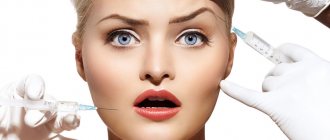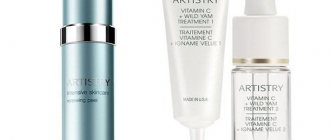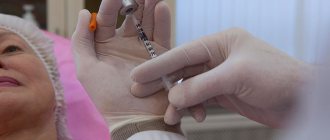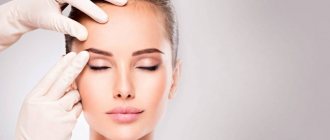Botox is a botulism neurotoxin that has undergone purification and pre-treatment and has a fairly weak concentration. The cosmetic effect of the drug was discovered in 1993, and two years later it became widely used not only in cosmetology, but also as a component of the treatment of many diseases.
Botox injections are a non-surgical corrective option for smoothing and eliminating expression lines and age-related wrinkles. In order to understand how Botox works, you need to understand the principles of the injection mechanism.
Why do Botox injections have to be repeated regularly?
The temporary, albeit quite long-lasting, effect of Botox injections is explained by the fact that the removal of wrinkles when using it is not normal for the body at a particular age and the body fights this effect quite effectively. Such a struggle and restoration of the “normal” for the body (and undesirable for the clinic client) skin condition with wrinkles and creases requires time, during which, in fact, the wrinkles are absent, but after which they appear again.
How does this happen?
When a cosmetologist injects botulinum toxin into a muscle fiber, the drug begins to diffuse (spread) along the fiber and reach its periphery. Here are nerve synapses - formations at the points of contact between nerve cells and muscles. When a nerve impulse travels through a cell, a cascade of chemical reactions occurs at the synapse, which ultimately leads to muscle contraction.
The mechanism of action of botulinum toxin on muscle cells.
When this muscle contracts, it compresses the skin that covers it and a wrinkle appears on it. When the muscle relaxes, the wrinkle disappears. If such contraction occurs very often, a permanently noticeable stripe appears on the skin at the site of the wrinkle. Such stripes are especially noticeable on the forehead, and in old age - around the lips, in the corners of the eyes and other places.
Due to differences in the emotionality and elasticity of the skin, such permanent wrinkles may appear at different ages in different people. For some, they form after the age of 35-40, when the skin becomes less firm and elastic due to age, while for others, permanent “creases” become visible already at the age of 25-30.
If Botox enters a nerve synapse, it binds a certain protein here, which is necessary for one of the reactions of impulse transmission from nerve to muscle to occur. As a result, even when a nerve signal is received, the muscle does not contract, the skin does not wrinkle and wrinkles do not appear. At the site of already formed creases, during additional procedures, the stripes may either disappear completely or become much less noticeable.
Botox actively fights wrinkles. Even if creases have been formed on the face for a long time, they become less noticeable.
On a note
This is exactly how the toxic effect of botulinum toxin develops when it enters the digestive tract. From here it is carried with the blood to the internal organs and also denervates vital muscles - the diaphragm, the muscles of the digestive tract, and the heart muscle. In case of severe poisoning, a person dies from suffocation or cardiac arrest. This option is excluded for the cosmetic administration of Botox, since during injections an extremely small amount of toxin is injected into the muscles, which is immediately distributed in the target muscles. From here it does not enter the bloodstream and does not reach vital muscles, which means it cannot lead to poisoning.
This result is very attractive for a person who does not like wrinkles. But it is also abnormal for the body - for it, the inability of a muscle to respond to an impulse from a nerve is a problem, an analogue of a disease. And as soon as the transmission of an impulse is interrupted at a particular synapse, the mechanism for the formation of a new duplicate synapse is launched. Once it is fully formed and begins to function, the muscle begins to contract again in response to a signal from the nerve. And with it, the skin wrinkles again and wrinkles appear again.
On a note
It is a mistake to believe that botulinum toxin is “washed out” from tissues or is somehow broken down by various substances in the body, which is why it stops working. In the synapse into which it enters, it persists for many years and actually completely neutralizes it.
According to histological studies, such a compensatory mechanism is launched almost immediately after the “switching off” of a particular synapse. It doesn’t matter how many synapses and on how many muscles were deactivated - exactly the same number of their backups begins to be created to restore muscle innervation.
Consequently, Botox and its analogues, after administration, last as long as it takes the body to “rebuild” new neuromuscular contacts. Since nerve tissue is one of the most conservative tissues in the body, this normally occurs relatively slowly. Practice shows that after the administration of botulinum toxin, eliminated wrinkles begin to appear again after a few months - from 3 to 9-12. Therefore, if you don’t want to observe these wrinkles, you need to inject Botox exactly after the period of time after which they begin to appear again.
Nerve cells recover much more slowly compared to other tissues of the body (from 3 to 12 months). This property is precisely used for Botox injections.
What influences the duration of this effect of botulinum therapy in a particular person?
Reviews
Alena Sukhovarova, 19 years old, Nizhny Novgorod
“Very early they started making comments to me that I already had wrinkles. I smile a lot, in general I am a very emotional person. I work part-time as a fashion model, as they noticed at work, I immediately ran to the cosmetologist. They recommended Botox because there were already very deep wrinkles between the eyebrows and nothing else would help. Awesome drug! A week later the creases completely disappeared. You can’t do it often, otherwise your body gets used to it. I will repeat it in six months.”
Irina Pautova, 26 years old, Moscow
“I have severe hyperhidrosis, and I work in an office. Always in white blouses, and sweaty armpits are not needed at all. No ointments helped, I tried deodorants from pharmacies. Then a friend told me that they were injecting Botox for this problem. The first time the result lasted for six months, now almost 9 months have passed and it’s still working.”
Speed of completion of the effect of Botox
Even before the first injection, it is impossible to predict exactly how long the effect will last. It depends on many factors, the most significant of which are:
- Individual characteristics of the body - metabolic rate, reaction to the drug, features of the structure and functioning of individual muscles. For example, it is known that professional athletes are much more likely to experience very rapid completion of the effect of Botox injections - within 2-3 months, which may be associated with very intense processes of tissue regeneration. In people with very expressive facial expressions, the effect of the drug injected into the facial muscles ends faster than in less emotional people, since their activity of both the muscles and the neurons that innervate them is higher, which is why restoration of innervation occurs faster;
- Specificity of the drug. It is known, for example, that the effect after the administration of Dysport (and its analog Azzalur) persists in most patients for 5-6 months, and the effect of Botox, Xeomin and their analogues lasts up to 9-12 months;
The effect of Dysport and Azzalur usually lasts no more than 6 months.
- The amount of the drug administered - in small dosages, the drug can stop the action of not all synapses and denervate not all muscle fibers, but only part of them. This will be enough for the wrinkles to disappear, but due to this, the restoration of full contractility of the muscle will occur faster;
- Location of the injected muscle. Thus, wrinkles on the back of the nose and on the forehead are usually eliminated for a longer period than in the corners of the eyes and around the mouth;
- Specific defect to be eliminated. It is well known that with the help of Botox and its analogues in cosmetology, they not only eliminate wrinkles, but also correct the oval of the face, smooth out a lumpy chin, and reduce the relief and “brutality” of individual muscles. Moreover, if Botox can eliminate a wrinkle on the forehead for six months to a year, then, for example, it can correct the relief of a “square” lower jaw for 2-3 years, and in some cases, for the rest of your life without additional injections.
It is also useful to read: Botox or biorevitalization: what is the difference?
You also need to take into account individual sensitivity to botulinum toxin. Some people have no effect at all from its use (among them there may be those who have had botulism), for others the effect is barely noticeable and goes away extremely quickly - in a matter of weeks. Such cases are rare, according to statistics, there are no more than 5% of such insensitive people, but this probability must be taken into account before the first procedure.
There is a category of people (about 5%) who are not affected by botulinum toxin. The effect of the procedure is either minimal or completely absent.
Finally, all these factors can overlap, and sometimes one person will have Dysport on their face longer than another person will have the seemingly stronger Botox.
Contraindications
- Pregnancy and lactation.
- Myasthenia.
- Taking certain antibiotics.
- Increased body temperature.
- Damaged skin.
- Blood clotting disorder.
- Alcoholism
- Hypersensitivity to the drug and proteins.
- Surgical interventions less than 3 months ago.
How often can and should you inject botulinum toxin preparations?
In the most general case, Botox can be injected as often as the need arises.
Simply put, as soon as a person has wrinkles or other defects that were eliminated after a previous botulinum therapy procedure, he can be given injections again.
On a note
It is incorrect to say here that a person “needs” to inject Botox. There is no urgent need for its cosmetic use - if the patient has wrinkles again, he can walk with them for as long as he likes, and carry out the subsequent procedure whenever he wishes. We can talk about necessity when it is critically important for a person that wrinkles or other defects do not appear again.
However, some restrictions exist.
For example, Botox should be injected no earlier than two weeks after the first procedure, since such additional injection is carried out in the same muscles as during the first procedure, if it did not give a complete result. However, any cosmetic manipulations, especially invasive ones, after injections are allowed no earlier than 10 days. Therefore, Botox can be injected into the same areas at intervals of at least 2 weeks.
If injections are planned to be given to different parts of the body, then the interval here, in the absence of generalized side effects, may be absent altogether. For example, if after injections in the forehead there is no allergy or flu-like syndrome, you can inject the drug into the neck, shoulders or legs the very next day.
If side effects from the administration of botulinum toxin do not appear, then the drug can be injected into other problem areas the very next day.
On a note
All of the above is true only for the cosmetic use of Botox. In medical practice, the frequency of its use in a particular patient is determined by the specific disease, its severity and the speed of recovery of symptoms after the procedure. In this case, only a doctor can decide how often the patient needs to inject Botox. The important thing here is that for medical indications, regular botulinum therapy is necessary, while for cosmetic use it is carried out only at the request of the patient.
In general, if we are talking about injections of Botox and its analogues, then they need to be injected approximately every 7-10 months. Dysport injections have to be repeated every 5-7 months.
Also, sometimes after the procedure it becomes necessary to “finish off” Botox if, for safety reasons, the doctor used too small an amount of the product the first time and the effect was not fully manifested. Such “finishing” can be carried out on days 12-14, and this interval is determined not so much by safety considerations as by the need to evaluate the full effect after the first procedure. On about 10-12 days this can be done: the effect of the drug is fully manifested and possible side effects of the drug, which may hide part of the result, disappear.
An interesting point: cosmetology practice shows that the longer a person regularly injects Botox, the longer the effect remains after each subsequent procedure and the less often he needs to repeat these procedures. This is true for most (though not all) patients under the age of 50-60 years.
Practice shows that in most patients under the age of 50, the effect of repeated Botox injections becomes longer each time.
It is believed that this increase in the duration of the effect is associated with regenerative processes in the skin. After the procedure, the muscle stops contracting for several months, in places of wrinkles, the skin restores its smoothness, regeneration of subcutaneous tissue occurs in it, and the strict spatial structure of the arrangement of cells is restored. Additionally, the muscle itself loses volume during its inactivity and weakens. As a result, when its innervation is restored, it can no longer shrink and wrinkle the skin with the same force, especially since the skin is no longer so “pliable” for wrinkling.
If, at the same time, the muscle is again immobilized at the first manifestations of its activity, it will not be able to lead to a violation of the structure of the intercellular matrix by constant impact on the skin, and will not lead to the appearance of visible defects on the surface of the skin.
This process will be intensified by the fact that a person gradually loses the habit of wrinkling those areas of the face or body in which the muscles are weakened by Botox. Over time, these muscles completely cease to be involved in the process of facial contractions, and even after the expiration of the botulinum toxin, they no longer contract on their own and do not cause the appearance of wrinkles.
Due to this, for people who inject Botox regularly, the intervals between procedures can increase to 14-18 months, during which wrinkles are not visible at all.
It is clear that this effect is very individual. Some people may have very pronounced facial expressions, while others may have skin that takes a very long time to recover. Also, in older people, due to thinning of the skin and loss of moisture, wrinkles form even without muscle contraction.
Due to age-related skin aging, in patients over 50 years of age, wrinkles form even without muscle work, so the duration of the effect of botulinum toxin injections is usually reduced.
However, at the age of 35-55 years, when getting rid of these defects is most important, for most people, the regularity of botulinum therapy ensures an increase in the interval between the procedures themselves.
As a rule, for most patients the intervals between procedures vary as follows:
- In the first 2-3 years they are injected every 8-9 months for Botox and every 6-7 months for Dysport;
- Then, over 2-3 years, the intervals gradually increase to 12-14 months for Botox and 9-10 months for Dysport;
- Then gradually the intervals reach 14-15 months for Botox and analogues, and 11-12 months for Dysport.
Perhaps in the future, procedures can be performed even less frequently. But the data for patients who have been injecting the drug for such a long time (more than 8 years) are currently insufficient for generalization due to the relative youth of botulinum therapy itself.
Review
I generally don’t get Botox injections very often. The first time I injected only in the forehead and between the eyebrows, after 4 months the effect disappeared, so I went to inject it again. The second time it was longer - the effect lasted 6 months, the next time the trip was delayed, it arrived after 8 months, although there were no obvious creases. 8 months have already passed, everything, like immediately after the injection, will probably drag on for a year. Although I think it’s better to have a little bit twice a year than rarely and a lot. Despite the fact that the first time they gave me 20 units, now they only give me 12 with the same result. The cosmetologist told me this: the muscles weaken, they can no longer squeeze the forehead, frown, and even when the effect ends, they do not immediately lead to wrinkles. Therefore, frequent use is only necessary at first, then you will need to inject less and less often. Yes, if it matters to anyone: I inject Botox. I have never used Dysport or Relatox.
Anzhelika, Moscow
Another deviation from the standard scheme is relevant for the use of Botox for bruxism, for smoothing an overly strong, “square” lower jaw, and healing scars. In these cases, one or two procedures may be enough to eliminate the defect for life.
One or two Botox injections are enough to permanently get rid of bruxism - nighttime teeth grinding due to spasm of the masticatory muscles.
For example, for people with too strong muscles of the lower jaw and, accordingly, a wide lower part of the face, it is enough to greatly weaken this muscle once with Botox, and then for several months give up the habits that led to such strengthening of the lower jaw: chewing chewing gum, an abundance of hard foods in the diet (dried fruits, minimally cooked meats, nuts), constant smoking of cigars and clenching matches with teeth. Without such physical exertion, the muscle weakens, loses some of its mass and volume, and the lower jaw becomes flattened. And when the activity of this muscle is restored, its volume no longer increases, since by abandoning the corresponding habits, a person no longer “trains” or “pumps up” it.
It is also useful to read: Botulax - the Korean analogue of Botox
From these considerations, it is clear that the earlier in age you start injecting Botox, the less often you will have to do it. When injections begin at the first hint of wrinkles, the skin at the site of the creases does not become thinner and retains its normal structure. In this case, even after restoration of muscle innervation, the wrinkles themselves will appear more slowly, and their severity will be insignificant.
On the contrary, if you start injecting Botox very late, some especially deep wrinkles will be very difficult to get rid of, and they will recover especially quickly.
Moreover, the age for the first injections is practically unlimited.
Long-term rejuvenation methods
Among BTA injections, Botox gives the most lasting results with a relatively small investment of time and money. But in cosmetology there are other methods that give longer lasting results.
- Contour plastic. For this procedure, serums that dissolve over time are used. The duration of the effect depends on the base of the drug. The most durable compositions last up to 4 years.
- Plasmolifting. Activates the skin rejuvenation process by introducing the patient’s blood plasma. Wrinkles disappear, the oval shape is tightened, the skin works in a more “youthful” mode. It is necessary to complete a course of 4 procedures. Effect up to 2 years.
- ELOS-rejuvenation. A hardware procedure based on electric current and light energy. Helps even out wrinkles, improve complexion, restore skin tone, remove pigmentation, scars, acne. Number of procedures 4-6. Results last up to 2 years.
- Facelift with mesothreads. Threads are inserted under the skin, which dissolve after 6-8 months. They help maintain skin in sagging areas for up to 2 years.
At what age can you start injecting Botox or its analogues?
There is no lower age limit for the use of botulinum toxins. Thus, in medical practice, children with cerebral palsy, spasms, and some other pathologies are injected with Botox from the age of 2-3 years, and according to the doctor’s recommendations, sometimes from the age of one.
Botulinum therapy is used to treat cerebral palsy from a very early age.
In cosmetology practice, the need for botulinum toxin injections appears no earlier than 20-25 years. Moreover, at this age, wrinkles appear only in a few - usually very emotional people with active facial expressions. If the need for wrinkle correction appears at this age, Botox can already be injected.
Other defects may need to be eliminated even earlier - a gummy smile, asymmetry in the opening of the palpebral fissures, and a strengthened lower jaw due to bruxism. To correct them, Botox can be injected as early as 12-15 years of age.
It is important to know
The ethics of cosmetologists dictate certain rules for the use of Botox against cosmetic defects that do not interfere with the patient’s normal life: only the patient himself should make a decision about the procedure. If for medical purposes children can and should be injected with drugs even when they cannot make such decisions due to their age, then correcting wrinkles or facial contours with Botox is possible only when the patient himself realizes the need. This allows you to avoid cases of exploitation of the child and his appearance to satisfy certain ambitions of the parents (for example, when people striving for the success of heirs, already at the age of 5-6, try to “sculpt” them into models with an ideal appearance).
How can you prolong the effect of injections?
There are no absolutely reliable and universal ways to prolong the effect of botulinum therapy, and at the same time reduce the frequency of procedures.
The most obvious way to guarantee a longer lasting effect is to inject Botox, or its analogues - Xeomin, Myoblok, Relatox and others. Although Dysport costs less, it also provides a shorter lasting effect.
Analogues of Botox, giving approximately the same duration of results.
Before the procedure itself, it is advisable to inform the cosmetologist about the desire to consolidate the result for as long as possible. To some extent, the doctor may increase the amount of the drug administered to extend its effect.
Another way, depending only on the patient, is to control their own emotions and contractions of those muscles that were denervated by Botox. Moreover, even when the effect of the drug ends, without excessive muscle contraction, wrinkles may not appear and not affect the condition of the skin for several months. And the greater this control, the longer it will not be necessary to inject Botox again.
Finally, you can extend the effect of Botox with additional procedures. If, for example, within a few weeks after botulinum therapy, fillers, primarily based on hyaluronic acid, are introduced into the areas of skin fractures, this will accelerate skin regeneration and slow down the restoration of wrinkles after the botulinum toxin wears off. In some cases, this effect of a complex procedure lasts for 1-2 years.
Administration procedure
The attending physician will select the right amount of the drug, taking into account the age, gender, treated area, depth of wrinkles and the wishes of the patient.
In order to determine the injection site, the patient must use the muscles that will be worked with - frown, smile, etc. After which, the doctor grabs the muscle and injects the drug with a thin needle.
The botulinum toxin injection procedure itself lasts about 15-20 minutes.
Injections go well with contouring, fillers, peelings, mesotherapy, and biorevitalization. Properly selected procedures help achieve the most effective and long-term results in the fight against aging.
Can disruption of the rehabilitation period shorten the duration of Botox?
At the same time, if you violate the doctor’s instructions after Botox injections, the effect of the procedure may end earlier. This is due to the fact that certain actions in the first days after injections can promote the diffusion of the drug into those muscles that were not intended to be treated. On the one hand, this increases the risk of side effects, since immobilization of unwanted muscles leads to unpredictable changes in facial expressions; on the other hand, the more the drug spreads over neighboring muscles, the less it affects the target fibers. Consequently, the effect is incomplete, fewer fibers are immobilized and muscle activity is naturally restored faster.
For example, Botox is injected around the eyes to combat crow's feet. The patient, in violation of the rules of the rehabilitation period, a day or two after the procedure, goes to the sauna, warms up his face and part of the drug diffuses into the muscles above the eyes. Because of this, eyebrows rise and the face constantly expresses surprise, and the wrinkles themselves are restored in 4-5 months instead of the planned 9-10.
Various actions can lead to such effects: playing sports in the first few days after the procedures, visiting a bathhouse or sauna, staying in the sun, bending deeply or sleeping in the first few hours after the injections, taking certain medications.
In the first days after the procedures, it is necessary to limit physical activity, exposure to the sun, and avoid thermal procedures.
A clear example of this situation is athletes who, due to a strict training schedule, begin physical activity within the first days after injections and the drug does not last long (this effect is also complemented by a generally faster metabolism due to increased stress).
Botox on the forehead and between the eyebrows (9 stages)
Wrinkles in the forehead area are very noticeable on the face, and this cannot please the female half of humanity especially. They are located vertically and horizontal grooves cross the frontal zone.
And, of course, there is a desire to get rid of such wrinkles. And injections with Botox will help with this.
The procedure is carried out in compliance with a strict sequence:
- The patient needs to stop drinking alcohol and antibiotics within 24 hours, otherwise he or she may face trouble.
- The cosmetologist will certainly disinfect the forehead area first.
- Next you will have to grimace a little. This will help the doctor mark the places on the forehead where he will then inject the drug.
- A point (at least 2 cm from the eyebrows) is outlined in a circle using a special marker or ordinary brilliant paint. This identifies the suspected zone that will be under the influence of the drug.
- The doctor does the same with other designated points.
- An anesthetic cream is applied to the injection areas. This is done in order to neutralize unpleasant (not painful!) sensations. But the patient has the right to refuse the gel.
- Then, using a very thin needle located at an angle of 45° or 90°, Botox is slowly injected under the skin to a depth of approximately 7 mm.
- Then a simple forehead massage is carried out to distribute the product equally evenly under the skin. In this case, swelling and hematomas do not form.
- After the session, the patient can spend up to 1 hour under the supervision of doctors, then he goes home. Properly performed manipulation does not leave bruises or redness on the forehead. There should be no pain (in rare cases, a slight headache may occur). After the “injection of youth” it is not forbidden to live in the usual rhythm.
For Botox injections in the forehead, only specialists are contacted. They know at what points on the forehead to prick the needle, to what depth and what number of units of product is required for this.
Pseudo-specialists may choose the wrong injection site and concentration of the drug, and this is fraught with extensive diffusion of Botox into adjacent tissues.
Which leads to partial or complete ptosis of the eyelid (closed eye). At-home procedures are also strictly prohibited. By penetrating a needle not into a muscle, but into a nerve, it is not difficult to cause paralysis (atrophy) for yourself or a friend.
By the way, the drug needs proper storage. He needs a temperature between -5 and +2 degrees. In this case, it can be stored for about 2 years.
MD Matheson Harris
Are constant botulinum toxin injections harmful?
In the most general case, regular botulinum toxin injections are as harmless as an injection performed once in a lifetime. Since the drug does not have a systemic effect on the body, it does not affect the general state of health in any way, and it can be injected relatively often.
However, you need to consider some of the consequences that may occur with long-term use of botulinum toxins:
- In areas where Botox is continuously injected, the muscles gradually lose their strength. Due to compensatory mechanisms, this can significantly affect facial expressions. Many people often have a certain unnatural smile, a calm or, conversely, irritated facial expression, although there seem to be no noticeable defects. The more competent the cosmetologist who performs the procedures, the lower the risk of such consequences;
- Botulinum toxin can provoke an immune response in the body, which will manifest itself in the fact that over time, its effectiveness, on the contrary, will decrease - the immune system will simply neutralize it more and more effectively. This does not happen often, but it is possible;
- Finally, the purely psychological aspect is important. Many people are so “carried away” by Botox that before each repeated procedure they begin to look for the smallest folds on the face, defects in the overall contours, and ask the doctor each subsequent time to inject the drug not only into already known areas, but also into new, completely different ones. This can lead to the fact that too many muscles will be denervated and facial expressions in general will be impaired - the face will either become unnaturally smooth, as if covered with wax, or the person will completely lose the ability to express emotions (the so-called “doll face”).
Sometimes a passion for Botox can lead to psychological disorders: a woman finds a physical defect where there is none.
In addition, many people develop psychological addiction to the procedures. If they have been injecting Botox for many years in a row, delaying or skipping the next procedure causes them anxiety, they worry that now all carefully hidden defects should immediately “come out”.
Botox injections do not cause physical dependence. If the drug is injected irregularly, no sensations arise after the expiration of the usual interval for a person.
Likewise, botulinum toxin preparations do not cause the kind of deformities that people like to scare each other with on the Internet by showing pictures of “Botox victims.” If Botox itself is not counterfeit, then it does not make your lips or cheeks swell, your eyes do not close, or your skin does not become rough. Moreover, Botox does not cause dementia, cancer or fistulas.
All such horror stories are a figment of the imagination, the results of the use of counterfeit goods or the illiterate indiscriminate use of fillers.
A few words about irregular injections
Likewise, occasional Botox injections are completely safe. It doesn’t matter whether you inject them strictly once a year, or completely without a schedule, the result of the injections, all other things being equal, will be the same. Unless, if the interval is too long, during which the wrinkles reappear and worsen, they will have to be eliminated with a large amount of the drug, and sometimes with complex procedures, while with regular injections you will have to constantly inject approximately the same amounts of the product. Simply put, if you miss the moment, you won’t be able to smooth out wrinkles with Botox alone.
All this means that Botox can be injected as often as required to maintain the desired effect and as the patient can afford. In some cases, individual restrictions are imposed on the frequency of procedures due to specific side effects, features of the defects being eliminated, but it is impossible to foresee this in advance. All such situations should be assessed only by a cosmetologist, who will develop an optimal injection program for the patient.
Useful video: when can you start injecting Botox?
When to add units
Based on the results of the first procedure, the cosmetologist adjusts the amount of the subsequent dosage of botulinum toxin.
| Durability | Changes |
| The effect lasted 4 months | Add 4 units |
| Result for 2 months | Add 6 units |
| Longevity for a month | Add 10 units |
If the patient has been injecting for a long time and the previous volume of the drug does not work, the doctor increases the dose. It should not exceed 50-60 units.











